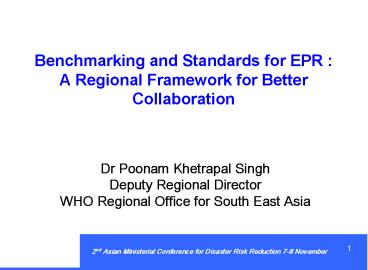Benchmarking and Standards for EPR : A Regional Framework for Better Collaboration - PowerPoint PPT Presentation
1 / 14
Title:
Benchmarking and Standards for EPR : A Regional Framework for Better Collaboration
Description:
Managerial and logistic issues within overall national disaster framework. ... Disaster risk reduction through ... Environment Health Management after disaster ... – PowerPoint PPT presentation
Number of Views:62
Avg rating:3.0/5.0
Title: Benchmarking and Standards for EPR : A Regional Framework for Better Collaboration
1
Benchmarking and Standards for EPR A Regional
Framework for Better Collaboration
Dr Poonam Khetrapal Singh Deputy Regional Directo
r
WHO Regional Office for South East Asia
2
Benchmarking A Regional Framework for
Collaboration
- Specialized Health Sector UN agency
- Established in 1948
- 193 Member Countries
- Six regional offices
- Covers 25 of the Worlds Population
- 28.9 of Disease Burden
- 26 of worlds poor
3
Benchmarking A Regional Framework for
Collaboration
- In a crisis situation public-health risks are
enhanced and can result in high rates of Diseases
and deaths - The health sector has a challenging
responsibility to respond timely, adequately and
appropriately - Being the UN Health Cluster Lead Agency core of
the WHO's function is to assist the Health Sector
(WHA 48.2, 58.1, 59.22). - These fall under 3 broad areas
- 1. Disaster Reduction Mitigation,
Prevention and Preparedness - 2. Coordinated Emergency Response
- 3. Norms and Standards
4
Benchmarking A Regional Framework for
Collaboration
- The need for improved preparedness is reinforced
by the vulnerability of the Region
5
Benchmarking A Regional Framework for
Collaboration
- Natural Hazards
- Earthquakes
- Cyclones, Storm Surges
- Floods
- Tsunamis
- Volcanic Eruptions
- Drought
- Man-made
- Conflicts
- Chemical accidents
6
Benchmarking A Regional Framework for
Collaboration
- All the countries of the SEAR have through the
years built their National Plans for disaster
management. - The National Disaster Plans have delineated
decentralized disaster management activities and
responsibilities in terms of Who, What When? - Inter-sectoral collaboration well established
health, army, Housing, Water Sanitation, Civil
Aviation and civil society organizations - Emergency Management Capacity installed in terms
of training and skilled human resources - However
- Disaster management remains response oriented
- Challenged with preparedness and pre-event
issues
7
Benchmarking A Regional Framework for
Collaboration
- The South East Asia Region of WHO, adopted the
benchmarks as a tool to measure the level of
health sector emergency preparedness in the
member-countries of the South East Asia Region of
WHO. - What is the purpose of benchmarking ?
- to address the key issues necessary to establish
disaster preparedness mechanisms in the health
sector - to identify gaps in addressing response,
preparedness and recovery for health needs of
affected and vulnerable populations. - to set standards for emergency preparedness
- facilitates planning, monitoring and evaluation
in a uniform manner
8
Benchmarking A Regional Framework for
Collaboration
- How were the benchmarks for EPR developed?
- The benchmarks are the product of a regional
consultation in Bangkok in November 2005. - Multiple stakeholders were present such as
Ministries of Health (MOH), Ministries of Home
Affairs, Foreign Affairs, Urban Development,
Local Government, Water Sanitation, Education
as well as UN agencies, International Federation
of Red Cross, International Non-Governmental
Organizations (INGO), Donor Agencies and Academic
institutions.
9
Benchmarking A Regional Framework for
Collaboration
- The twelve benchmarks with a corresponding set of
standards and indicators fall into the categories
of - Disaster Risk Reduction through Mitigation,
- Prevention and Preparedness
- Public Health Risk vulnerability
- assessment at community level
- Policy, Legislation and Planning
- Managerial and logistic issues within overall
national disaster framework. - Human resource development, training and
education
10
Benchmarking A Regional Framework for
Collaboration
- Risk Reduction through Coordinated Health Action
- Health sector coordination with different sectors
and NGOs - Patient care prevention of communicable disease
outbreaks - Surveillance and reporting
- Patient Care Mass Casualty Management and
Hospital Care - Facilitating enhanced National Responses capacity
and Funding (SEARHEF and RB)
11
Benchmarking A Regional Framework for
Collaboration
- Disaster risk reduction through Norms and
Guidelines - Health Sector Guidelines on different emergency
health sector management issues such as - Health Sector Planning
- Rapid Health needs assessment protocols
- Humanitarian Supply Management System
- Establishing Emergency Hospital Management
System - Disease Outbreak Control
- Environment Health Management after disaster
www.searo.who.int/drd/eha
12
Benchmarking A Regional Framework for
Collaboration
13
Benchmarking A Regional Framework for
Collaboration
- How will the Member countries use the Benchmarks
Framework? - To achieve the benchmarks is a long-term process
- Guiding principles
- Countries will vary in their attention to the 12
benchmarks. - Each country would prioritize its interventions
14
Benchmarking A Regional Framework for
Collaboration
- The gradual achievement of the benchmarks at
various levels will serve to - build capacity,
- secure inter-sectoral linkages
- improve planning and legislation
- reduce the vulnerability of communities and
systems.































